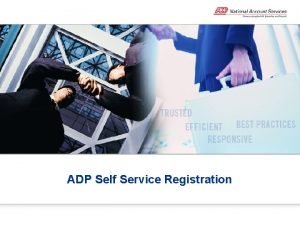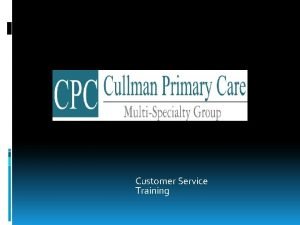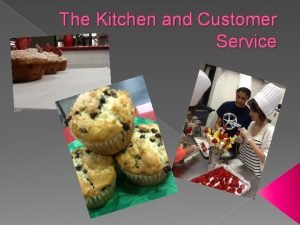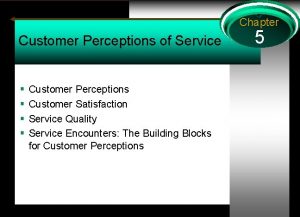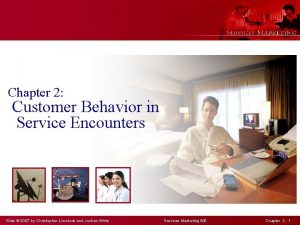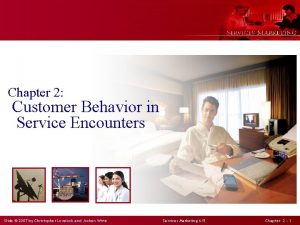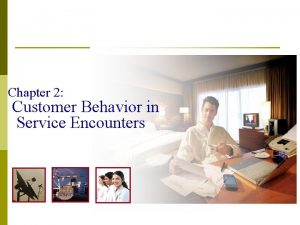Chapter 5 Managing service encounters Hudson Hudson Customer












- Slides: 12

Chapter 5 Managing service encounters © Hudson & Hudson. Customer. Servicefor for. Hospitality&&Tourism

Topics covered o The employee’s role in delivering service o 15 techniques for delivering guest service o The art of customer service training o The customer’s role in delivering service o The importance of customer-to-customer interactions o Enhancing customer participation

‘At Your Service’ Spotlight: Ten Travel in Tenerife Wooing businesses and keeping travelers happy. o Business and incentive travel - high level of specialization • Positioned between tourism and business • Solving problems for customers • Maintaining service levels • Beyond usual tourist trips o Employing and retaining the ‘right people’ • Dedicated local experts o Behind the scenes • Service negotiations, recovery • Detailed planning • Budget considerations

Employees’ role in delivering service o Service encounters first and foremost social encounters o Interactive marketing occurs at the ‘moment of truth’ o Service quality judged over five dimensions: • Assurance • Empathy • Reliability • Responsiveness • Tangibles o ‘Emotional labor’ • Engage strangers • Suppress real feelings • Cope with emotional stress

15 service techniques at ‘the moment of truth’ CUSTOMER SERVICE TECHNIQUE DESCRIPTION 1) Promptly greet all customers Nobody likes to be ignored, made to wait. Greet the customer like a guest in your own home 2) Use appropriate icebreakers Break the ice with safe conversation starters, build rapport based on common interests 3) Compliment freely and sincerely Customers love to be complimented – even if they know it may not be truly genuine. 4) Call customers by their name (if known) People love nothing more than the sound of their own name. . 5) Make and maintain eye contact with customers Eye contact creates a bond between you and your customer. You are creating ‘Involvement. ’ 6) Ask for feedback You want to know as soon as possible if there any problems in the service delivery. 7) Listen carefully Use appropriate nonverbal signals and receptive language; listen to what the speaker is saying. 8) Use effective service vocabulary Use positive phrases and words that build customer rapport and loyalty. 9) Smile freely and often Customers often indicate that they feel valued when they receive a smile. 10) Appropriately touch customers when possible Physical touch is a powerful form of communication. 11) Enjoy people and their diversity Avoid the tendency to judge; accept diversity for the quality it brings to our lives. ! 12) Have a good attitude about your job You will benefit from having a positive attitude about life. 13) Keep your workplace clean and attractive It is important to create a strong first impression by keeping the workplace attractive to the eye 14) Dress and groom yourself appropriately Determine what level of professionalism you want to convey and dress appropriately 15) Maintain a good body posture Posture involves the way you position your body. You should appear attentive and ready to assist. Table 5. 1 (based on Timm, 2008)

Customer service training ‘We are ladies and gentlemen serving ladies and gentlemen. ’ - Ritz Carlton company credo o 64 % of HR executives advocate more customer service training o Service oriented firms reluctant to invest in training o Small firms wary of time, finances, resource investments o Strong correlation between training, employee retention o Requires more than a single program or class • Initial and ongoing (se. g. Disney) o Service providers may look externally for training o Should include how to service ethnically and socially diverse customers (eg. customers with disabilities)

Snapshot: Steamboat Springs training for service excellence o In 2014 decided to train the whole community in customer service techniques via the Service Excellence program o The program teaches the very latest in customer service culture and uses many Disney examples of ‘going the extra mile’. o The course includes techniques such as the connection stack, finding common ground with customers and then using that more intimate relationship to gain their confidence and loyalty to the destination.

Customer role in delivering service o Customer participation in service delivery and co-creation o Employees (actors), consumers (audience) interact in servicescape (service setting) o Customers can play three major roles in service delivery • Productive resources ⁻ Customers as ‘partial employees’ • Contribute to personal satisfaction ⁻ Service outcome dependent on customer participation ⁻ Customers contribute to quality service delivery • Potential competitors ⁻ Internal or external exchange

Customer-to-customer interactions o Service consumption in the presence of other customers o Interactions impact consumption experiences o Important to both consumers and companies o C 2 C interactions successfully fostered e. g. Harley Davidson, Jeep, Apple, Saturn o Enhance quality of life through social interactions • ‘Third spaces’ o Managerial involvement in facilitating C 2 C o Relationship between consumer interactions and satisfaction outcomes

C 2 C Interaction Studies Table 5. 2

Strategies for enhancing customer participation Figure 5. 1. (based on Zeithaml et al. , 2007)

Case Study: Hotels getting social to compete with the sharing economy o Hotels are realizing that to compete, they need to provide a more authentic, engaging, and social experience o This can be as simple as hosting a social hour for guests on arrival (eg. Sutton Place Hotel in Revelstoke, Canada) o Or completely redesigning spaces in order to encourage social interaction. (The M-Beta in Charlotte & The Bivvi Hostel in Breckenridge, Colorado) o One hotel that has developed a strong culture of social interaction and emotional engagement, all wrapped in an aura of authenticity, is the Limelight Hotel in Aspen
 Managing customer information to gain customer insights
Managing customer information to gain customer insights Fun facts about henry hudson
Fun facts about henry hudson Perbedaan customer relation dan customer service
Perbedaan customer relation dan customer service Transoceanic encounters and global connections
Transoceanic encounters and global connections Chapter 22 traditions and encounters
Chapter 22 traditions and encounters Chapter 18 colonial encounters in asia and africa
Chapter 18 colonial encounters in asia and africa Chapter 5 political transformations empires and encounters
Chapter 5 political transformations empires and encounters Chapter 23 transoceanic encounters and global connections
Chapter 23 transoceanic encounters and global connections Chapter 22 transoceanic encounters and global connections
Chapter 22 transoceanic encounters and global connections Bentley and ziegler
Bentley and ziegler Chapter 1 section 5 transatlantic encounters
Chapter 1 section 5 transatlantic encounters Chapter 22 transoceanic encounters and global connections
Chapter 22 transoceanic encounters and global connections Adp manager self service
Adp manager self service












